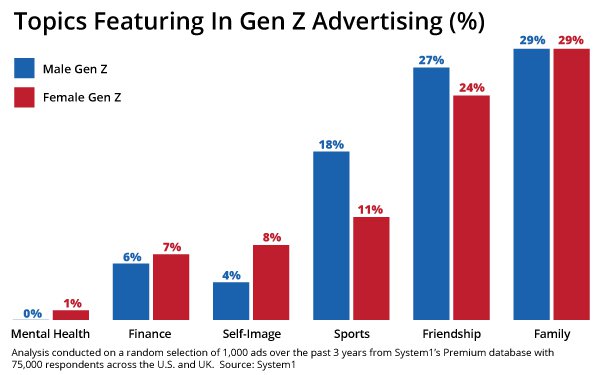
Across nearly every group, when people feel
genuinely recognized on the screen -- meaning they feel represented in the message -- they have more positive thoughts about the ads viewed, according to a recent study.
But there is one
glaring omission. One group could not see themselves in the ads -- Gen Z. This first generation raised on cell phones rather than TV socializes less face-to-face, lives more through TikTok and
Instagram, and will reach adulthood in the middle of an artificial intelligence (AI) boom.
After analyzing 1,000 U.K. and U.S. ads from System1's subscription ad database, with 75,000
respondents, the company's analysis shows marketers have overestimated the influence of Gen Z -- those born between 1997 and 2012.
Gen Z, per System1, represents 25% of the global population,
but some 93% of ads feature a representative from Gen Z, and 48% are central or main characters in the U.S. Some 78% and 35% were represented in the U.K., respectively.
advertisement
advertisement
“The industry is
obsessed with Gen Z, but it’s missing the mark,” said Jon Evans, chief customer officer at System1. “Brands need to meet them where they are, on the platforms they use most, with
content that feels emotionally real and meaningful.”
Evans notes that marketers over-generalize and under-deliver for this age group. Marketers need to stop defining them by stereotypes
and start seeing them as individuals shaped by unique context and experiences, he added.
Using System1’s “Test Your Ad” platform, the study analyzed 65 ads featuring Gen Z
characters, tested with Gen Z men and women.
Ads were assigned a star rating, based on emotional response, which predicts the long term brand-building potential of the creative.
The
results also demonstrate a drop in emotional impact. Ads targeting Gen Z women saw an average 0.6-star decline in long-term brand-building potential, compared with ads aimed at Gen Z men. Those ads
performed worse, with a 1.5-star decline.
On social platforms, the gap widened even more, as resonance scores dropped by 1.7 stars with Gen Z women and 2.5 stars with Gen Z men.
The wider analysis of 1,000 ads from System1's Test Your Ad database showed that less than 1% of Gen Z portrayals of this age group addressed mental health, while only 6% are related to body
positivity or financial pressures -- which made it even more interesting because, apparently, those are three of the generation's top concerns.
“Gen Z has a significant focus on mental
health, which is driven by higher reported rates of anxiety and depression compared to previous generations and is reflected in their openness to discussing it, seeking professional help, and
expecting support from employers and brands,” according to MSU
Denver, from an article in September 2024.
But mental health is not the main focus of Gen Z. In this demographic, only 1% females say they are concerned about it, and 0% of males. Females
and males are most concerned about family, at 29%; followed by friendship -- with females at 24% and males at 27%; and sports at 11% and 18%, respectively.
One clear finding from System1
research is that male and female Gen Z audiences respond to different themes.
Body-positive ads connected strongly with women, while stories centered on kindness, gratitude, and generosity
resonated more with younger men.
It’s a reminder that Gen Z is not one uniform group. They share concerns around all types of challenges apart from mental health including money,
environment and AI. But what strikes a chord within those topics can differ.
It may also be a surprise to some brands that sports did not emerge as a primary driver of happiness for men.
Testing early and often helps avoid those easy assumptions and uncover insights to build effective creative upon.
The best way to engage this generation is to find the right topic for the
right audience, then build the creative from that starting point.